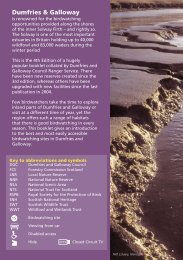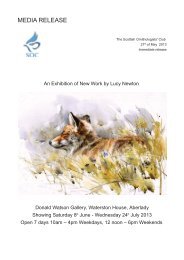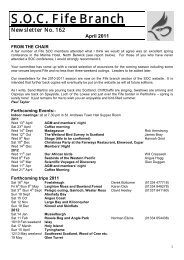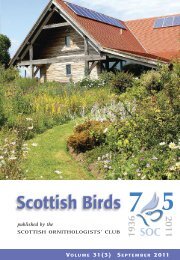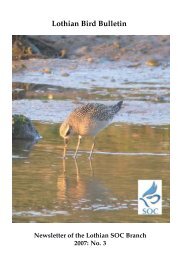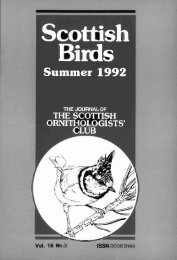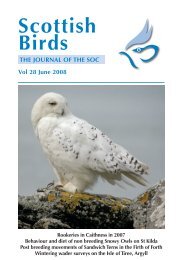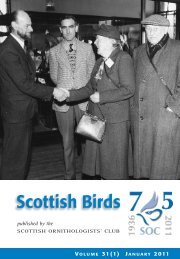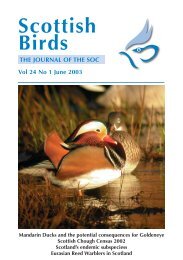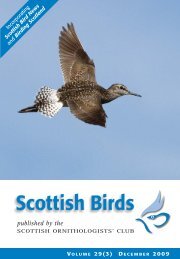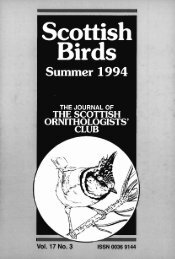V 14 No.4 - The Scottish Ornithologists' Club
V 14 No.4 - The Scottish Ornithologists' Club
V 14 No.4 - The Scottish Ornithologists' Club
Create successful ePaper yourself
Turn your PDF publications into a flip-book with our unique Google optimized e-Paper software.
192 A. Watson & R. Rae<br />
S8 <strong>14</strong> (4)<br />
young were well feathered, but still retained<br />
some down, and so were not fully grown<br />
or fully fledged.<br />
At the end of each area section in the<br />
Results, the first figure (max.) is the largest<br />
number of pairs seen in any year there since<br />
1973, and the second (est.) the estimated<br />
total number of pairs each year. <strong>The</strong> first<br />
figures cannot be added to give a grand<br />
total, as many are from different years. To<br />
get the second figure, we took the first one,<br />
estimated by eye on the map the approximate<br />
area that it applied to, added by eye<br />
any extra areas where Dotterel have been<br />
seen in one or more years, and multiplied<br />
according to the visually estimated area of<br />
other suitable-looking ground. This was<br />
necessarily rough, as few observations involved<br />
complete searches of measured areas.<br />
For these calculations we assumed that<br />
Dotterel were present every year on every<br />
hill where they have been seen even just<br />
once. For example, an observer might see<br />
a pair on Hill A in 1985 and a pair on nearby<br />
Hill B in 1986, but might not search Hill<br />
B in 1985 or Hill A in 1986; this would appear<br />
in the Results as two pairs, but there<br />
might be only one. On some hills which are<br />
well known haunts, birds have been found<br />
breeding on every late-summer visit by an<br />
experienced observer. However, in most<br />
cases in the east, and nearly all in the west<br />
Highlands, the notes covered only one or<br />
two visits per hill over many years. This<br />
possible error will be overcome only if<br />
observers go to a reasonably big sample of<br />
hills in the same summer.<br />
We assumed, as there was no evidence<br />
for doing otherwise, that numbers on each<br />
hill were fairly constant each year, as on<br />
A. W. 's three study areas. However, these<br />
study areas are all on good habitat, and may<br />
export birds to less suitable ground.<br />
Numbers on sites that may be marginal<br />
possibly fluctuate more; perhaps such sites<br />
may be colonised each year by a varying<br />
overspill only after the better places are fully<br />
occupied. A regional survey in one year<br />
could not overcome this problem; several<br />
years study of good and possibly marginal<br />
nearby sites would be needed. If many sites<br />
prove to be marginal, with few or no birds<br />
in some years, our total will be too high.<br />
However, it may be too low for other<br />
reasons (see Habitat, below).<br />
Distribution and numbers<br />
<strong>The</strong> following notes refer to years since<br />
Nethersole-Thompson's book (1973), except<br />
for pre-1973 information that was not in the<br />
book. We use "hill" to mean a separate,<br />
distinct hill, not a subsidiary top or summit.<br />
Above 3000 ft (9<strong>14</strong> m), it corresponds to the<br />
term "Munro" , and below 3000 ft to other<br />
lesser but separate hills as defined in<br />
<strong>Scottish</strong> Mountaineering <strong>Club</strong> guides<br />
(Donaldson, 1984).<br />
Aberdeenshire-Banffshire, east of the<br />
Caimgorms massif. Pairs have been seen on<br />
eight hills. Young have been reared on three,<br />
and nests found on two others. Max. 6, est.<br />
10+ .<br />
Aberdeenshire-Angus. Has bred on six<br />
boundary hills between the Perth-Braemar<br />
road and Kincardineshire, and on three hills<br />
to the north, with 5-7 pairs annually on a<br />
study area on part of one hill. On another<br />
hill, an observer came across seven nests in<br />
1979 . Found breeding on every late-summer<br />
visit to six hills. Max. 32, est. 70 + .<br />
Angus. Has bred on three hills between<br />
Glen Isla and Glen Clova, on one between<br />
Glen Cl ova and Glen Esk, and on one in<br />
Glen Esk, and has been seen on two other<br />
hills in Glen Esk. Max. 6, est. 10 + .<br />
Kincardinesbire. Pairs have been seen<br />
in June at four sites on three hills, an adult<br />
in July at one of them, and an adult in early<br />
August on a fourth hill. At 580 m on one<br />
hill, 6-7 have been seen together in late Julyearly<br />
August in several years back to the<br />
early 194Os, and in July 1942 or 1943 a<br />
gundog picked up a flightless chick. Max.<br />
4, est. 5 +.<br />
Aberdeenshire-Perth. Has bred on five<br />
boundary hills from Inverness-shire to<br />
Angus, and on three to the north, including<br />
tops down to 750 m. Max. 13, est. 20+ .<br />
North-east Pertbsbire. Has bred on



